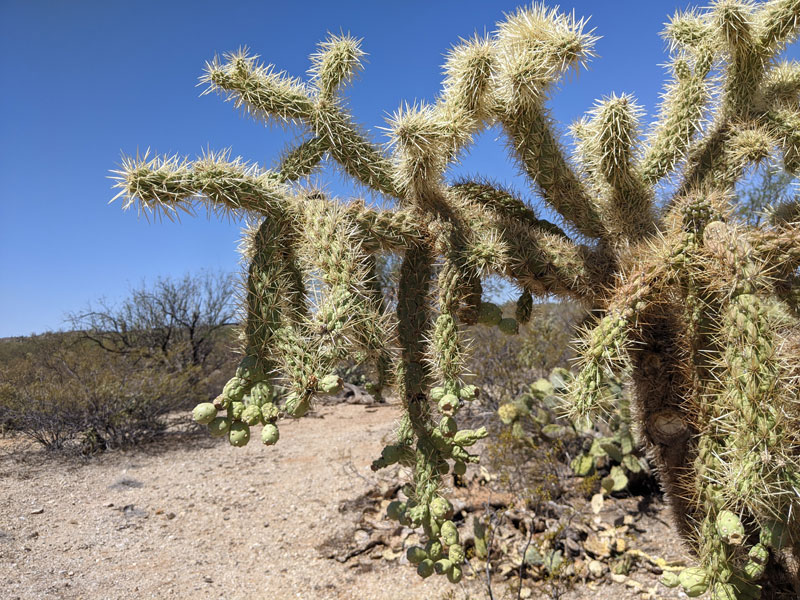The saguaro cactus is truly a sight to behold up close. There are thousands of them here in the Saguaro National Park East Unit, and I’m looking up at one that must be about 20 feet tall.

Saguaro National Park is split into two units separated by 30 miles – the west unit (Tucson District) and the east unit (Rincon District.) The east district is named after the Rincon Mountains, and its highest point, Rincon Peak, stands 8482 feet above sea level.
Due to its heavier density of saguaro cacti, plus its petroglyphs and sweet aerial view of downtown Tucson, the west unit of Saguaro is more popular with tourists than the east unit.
I’m here to give a little love to the east side and let you know what you can see and do when you decide to spend a day in the Saguaro National Park East Unit.
The main activities here are hiking, following the scenic drive, and maybe wildlife watching if you’re lucky.

Read on to learn what you can see and do during a single day in the Saguaro National Park Rincon Mountains East Unit!
Some fun facts about Saguaro National Park
Saguaro is one of three US national parks (along with Joshua Tree and Redwood) to be named after a single plant. People may visit Yellowstone or Glacier NP to see wildlife and mountain views, but here, they come for the cactus!
The saguaro cactus itself doesn’t grow arms until it reaches about 75 years old. You’ll see that many of these cacti have no arms yet, so you can deduce that they are younger. A saguaro can have as many as 25 arms!
The saguaro can live to almost 200 years old! They sprout white flowers in the spring and red fruit in the summer. I visited the first week of June, and was still able to see flowers in bloom on many of the plants.

The saguaro is mainly found in the Sonoran Desert of Arizona and Mexico. There are a few in California as well. The cacti need the summer rains, which they retain to get them through the year.
Saguaros can grow to 40-60 feet tall. They are the tallest cactus in the United States. They produce fruit that ripens in late June.
The saguaro cactus blossom is actually the state flower of Arizona! It’s a pretty flower, so you can see why they chose it.
Things to Bring to Saguaro East Unit
-Water bottles. This is extremely important! Bring 3x as much as you think you’ll need. The visitor center at Saguaro East has water bottle refill stations you can use to restock your supply.
-Sunscreen
-Sunglasses
-Car charger for phone
–National Parks Passport. Bring your official NPS booklet and get your park stamp at the visitor center!
-Other skin protection. Bring a hat or something else to protect your skin, especially if you visit during the searing heat of the day.
–Saguaro National Park Hiking Guide. If you plan to hike a lot, having a physical copy of a hiking book can be a lifesaver. This one covers all the hikes in Saguaro NP and surrounding areas of Arizona.
Things To Do and See at Saguaro National Park East

Saguaro East only has one loop road. The rest of this park is desert wilderness, accessible only by hiking or mountain biking. There’s also a desert forest at the higher elevations.
Cactus Forest Loop Drive is only 8 miles long, but you can see a lot on this road. It has numerous pullouts with scenic views, hiking trailheads, picnic areas, and interesting natural features.

The drive is mostly one-way, so you don’t even have to make a decision about which direction to travel. Just follow the road!
If you’re visiting the Saguaro National Park East Unit, here are the must-see attractions and activities along Cactus Forest Loop Drive.
Rincon Mountain Visitor Center
Your first stop in Saguaro East will be Rincon Mountain Visitor Center, the only visitor center on this side of the park. Get your park maps, use the restroom, and fill up your water bottles.
You’ll pay your entrance fee just after the visitor center as you enter Cactus Forest Loop Drive.
Riparian Overlook

Cactus Forest Loop Drive has several overlooks. Riparian Overlook is my favorite, as it provides the best views of the cactus forest itself.
You can look across at the mountain peak in front of you, and look down at the valley below with thousands of cacti soaking in the sun.
Javelina Rocks
Have you ever heard of the javelina? It’s a pig-like mammal that only reaches about 20 inches tall. These critters live in the desert, and they especially love the area of Saguaro now known as Javelina Rocks.
This section of the park features huge rocks that you can climb on and around. It’s one of the more unique features of Saguaro East, so be sure to stop here to walk the short trails!

The park brochures say that javelinas can often be spotted here, although I had no such luck. But I did enjoy playing on the rocks.
It reminded me of a smaller version of Nevada’s Red Rock Canyon or the Jumbo Rocks in Joshua Tree National Park.
Mica View Road
Mica View Road is a short dirt / gravel road, so be careful if you’re driving a rental car, as some companies don’t allow driving on non-paved roads.
The road leads to a picnic area and a couple of trailheads. It’s a decent detour, but you’re not missing too much if you have to skip it.
Sonoran Desert Overlook

The Sonoran Desert Overlook is one of the first little pullouts on the road. The views are so-so, but this stop does provide some excellent informational boards that describe the different types of cacti you can see in the park.
Complete List of Stops on Cactus Forest Loop Drive in Order:
Rincon Mountains Visitor Center
Future Generations Overlook
Sonoran Desert Overlook
Cactus Forest Overlook
Mica View Road
Desert Ecology Trail
Cactus Forest Trail to Lime Kilns
Loma Verde Trailhead
Riparian Overlook
Rincon Mountains Overlook
Javelina Rocks
Freeman Homestead Nature Trail
Javelina Picnic Area / Tanque Verde Ridge Trail
Saguaro East Hiking Trails to Consider

You’ll definitely want try some of the hiking trails in Saguaro National Park East. These trails range from short nature trails that can be done by even folks with limited mobility, to much longer trails that require overnight camping.
Getting away from the road and exploring the trails is the best way to see various types of desert plant life up close. You’ll find tons of different types of cacti here, not just the saguaro!
WARNING: Hiking in Saguaro can be very dangerous, especially in summer, when temperatures reach well over 100 degrees F.
The park warns visitors to hike as early as possible, and try to finish your hike and be back at the trailhead by 11 am.
Hikers are also warned to turn around whenever half of their water is gone. Regardless of your level of physical fitness, heat stroke can strike anyone.

Keep your hikes very short when it’s hot. Since I was hiking alone, I decided I wouldn’t do any hike longer than two miles.
Yet as I was completing the hike, I still found myself feeling a little faint from the heat and had to take a water break in the shade of the cacti to avoid passing out. Take frequent water breaks, and always let someone know where you are going.
Ranked in order from easiest to most difficult, these are some of the best hiking trails in Saguaro National Park East Unit:
• Easy: Desert Ecology Trail (0.3 mile loop, △10 feet elevation gain)
• Easy: Freeman Homestead Nature Trail (1.1 mile loop, △105 feet)
• Moderate: Cactus Forest Trail to Lime Kilns (2.2 miles out & back, △100 feet)
• Moderate: Loma Verde Trail (3.8 mile loop, △60 feet)
• Strenuous: Tanque Verde Ridge Trail (17.4 miles out & back, △4000 feet)
The Desert Ecology Trail and Freeman Homestead Nature Trail are both easy walking trails suitable for people of all ages.
The latter highlights specific plants with information boards describing the shrubs and cacti along the trail.

The Cactus Forest Trail is one of the best Saguaro East hikes. The full trail runs about 10 miles, but that’s way too long in the heat of summer.
I recommend parking at the trailhead and hiking one mile south to Lime Kilns, where you can see century-old stone structures that were used for turning limestone into mortar and plaster.
The Loma Verde Trail cover nearly four miles, if you choose to hike the entire thing. I saw lots of cactus flowers in bloom on this hike.
Finally, the Tanque Verde Ridge Trail is the one that covers nearly 9 miles each way. Starting at the Javelina Picnic Area, the trail follows the ridge line all the way up to Tanque Verde Peak at 7049 feet elevation.
Obviously, day visitors to Saguaro aren’t going to make this long hike, which requires an overnight camping stop.
But I do recommend doing at least the first mile or two of the Tanque Verde Trail, because it’s one of the few day hikes with some decent elevation gain and it shows off landscapes that are more rocky than the mostly-flat terrain around Cactus Forest Loop Drive.

You can even hike all the way up to Mica Mountain, the highest point in the park at 8666 feet, though this is more commonly done using Douglas Spring Trail rather than Tanque Verde.
Wildlife of Saguaro National Park East
Rattlesnakes are one of the most prominent animals in Saguaro East, and there are signs everywhere warning you to keep your eyes and ears open for them.
Unlike Roosevelt National Park, where I saw several snakes, I didn’t see any during my Saguaro visit. But that could be because I was there mid-day, and snakes love the later afternoon and early evening hours.
The park has a few different types of rattlesnakes. They tend to be most visible during the late afternoon and early evening hours when the sun is still strong.
Mountain lions. The park warns that mountain lions are active in the area, at all elevations. If you are doing any long hikes, it’s best to hike with a friend.
Bears. The forested higher elevations do have black bears. You won’t encounter any in the park of the park where you’ll be driving.
Birds. Birds are everywhere! You can see them pecking holes in the saguaro cactus and flying in and out of those holes.

Javelinas. As noted, these little critters like the rocky areas of the desert.
Scorpions. Always watch your step in the desert, because snakes or scorpions can be right on the trail and you don’t want to have a close encounter!
Camping and Hotels Near Saguaro National Park East Unit
What lodging options do you have near Saguaro East and Tucson? Camping is always an option. The park itself has six small campgrounds, with 3-6 sites at each.
They are mostly at higher elevations, ranging from 4800 feet at Douglas Spring to 7920 feet at Manning Camp.
All require a minimum of a 4-mile hike to reach them. These are not car camping sites where you can drive right to the campsite.
Outside the park, your closest camping options include the Cactus Country RV Resort, Pima-Swan RV Park, and Rincon Country East RV Resort.

As for hotels near saguaro national park east, just find one of the nearby hotels in the city of Tucson.
It’s great that a number of properties are within a 20-minute drive of the park. That is not the case with most national parks!
Recommended hotels:
Desert Trails Bed & Breakfast. If you’re willing to splurge, check out this cute B&B for free wifi, free parking, flat screen TVS in every room, all just an 8-minute drive from the park. This is the closest lodging to the park entrance!
Hampton Inn Suites Tucson Tech Park. For something more affordable, try this Hampton, located about a 16-minute drive from the park entrance.
FAQs: Saguaro National Park East Visitor Center, Weather, and More
Where is the Saguaro East visitor center located?
As noted, the Rincon Visitor Center is right at the park’s main entrance on the east side. If you need GPS assistance, the address is 3693 S Old Spanish Trail, Tucson AZ, 85730.
You will find bathrooms and water bottle refill stations at Rincon Visitor Center. The center is generally open from 9 am to 5 pm daily, but double check the hours because sometimes they change.
(One recent summer, the visitor center was totally closed on Tuesdays and Wednesdays due to short staffing.)
Is there a welcome sign at the East Unit?

Yes. It’s small, and it’s right along the main street (S Old Spanish Trail) that you turn off to head into the park. Just past the welcome sign, there is a small area where you can pull off to stop and take a welcome sign pic.
I’m not sure if it’s meant to be an official pullout, but it was large enough for me to park and run over to snap a quick photo.
How long is the drive between west & east?
As mentioned earlier, the two sections of Saguaro National Park are about 30 miles apart.
It will take about an hour to drive between them, because you’ll be passing right through the city of Tucson, with its traffic and stoplights. At least there are plenty of gas stations to refuel along the way!

How is “saguaro” pronounced?
The word “saguaro” originated with the Ópata people of Mexico’s Sonoran Desert, and therefore it uses the same kind of pronunciation you’d hear in Mexican Spanish.
That means the G is silent, and the UA together make a W sound. So saguaro is pronounced Sa-WAH-roh, with the emphasis on the second syllable.
Entry fee: How much does it cost to visit Saguaro East?
A single vehicle pass to enter Saguaro is $25. The pass is good for one full week and gets you entry to both the West and East Units, as many times as you like. A motorcycle pass is $20.

If you enter by foot or by bike, the fee is $15. Saguaro is one of the few national parks that is right near an urban area, so it’s possible to Uber or Lyft right to the entrance of Saguaro East if you like, and then walk around Cactus Forest Loop Drive without a car (but be prepared for the heat!)
An annual pass for Saguaro National Park from the National Park Service is $45. You’re probably better off buying the Annual Pass from the NPS that gets you access to every national park in the country, as that one runs $80.
What is Saguaro National Park weather like?
It’s a desert, so expect hot, relentlessly sunny, and dry. From June through August, high temperatures average 100 degrees F.
December through March are the coolest months, with highs in the 65-70 range. Much more comfortable for a long hike!
It rains in the Tucson area an average of 2-3 days a month, with a high of 5-6 days of rain in July and August. Be aware of summer thunderstorms that could come out of nowhere.

Occasionally, storms close Cactus Loop Road entirely. This past July, the road was closed for several days due to powerful monsoon rainstorms that caused water to flood the road.
What’s the best time to visit Saguaro National Park East Unit?
I visited in May, and that was not ideal, as temperatures were already approaching 100 degrees F during the day. If you come from June through August, it will be even hotter, and you may have to deal with heavy rain.
Therefore, the best time for a Saguaro trip with comfortable temperatures is during the winter, from roughly October through March.

That said, if you want to see the cactus flower blooming, May and June are better times to stop by. It’s very cool seeing this prickly, dull green cactus sprouting these beautiful flowers!
What type of cactus can you see in Saguaro East?
Although the saguaro is the star of the show, you’ll see several other types of cactus in the park, including various cholla and prickly pear cactus.
This view from a trail I hiked shows at least 4 different cactus types! Read here for more info.

Is there cell phone access throughout Saguaro East Unit?
For the most part, yes. You may find some spots, especially if you head out on some of the more remote trails, where your cell phone will not have access to mobile data. As for wifi, there is no public wifi at the visitor center.
How far is the drive from Phoenix to Saguaro National Park?
From downtown Phoenix to Saguaro National Park East Unit, you’re looking at about 134 miles and 2 hours, 10 minutes of driving. So you can totally visit Saguaro in a day trip from Phoenix.
It’s even quicker to reach Saguaro West Unit from Phoenix – just 90 minutes or so.
While you’re in Arizona, consider also visiting Petrified Forest National Park.
What’s your favorite part of the Saguaro National Park East (Rincon) Unit?


